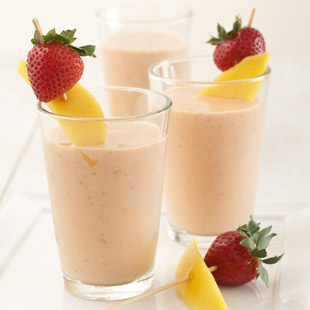Health benefits of juicing vs. smoothies

Juicing and smoothies are all the rage right now. While both can boost your fruit and vegetable intake (something most Americans need to do) and are great for getting a variety of produce into your diet, one is the better choice.
That’s the smoothie. Why? Juicing leaves behind a pulp—which contains fiber and nutrients that you end up tossing away—and thus you lose most of the benefits of whole fruits and vegetables. Blending produce into a smoothie, however, preserves fiber—and a smoothie can deliver an extra boost of vitamins, minerals and phytochemicals because it often includes fruit skins and pith. If your smoothie includes yogurt or milk, you get some calcium too. Blending, however, introduces oxygen and sometimes heat, which will knock out a little vitamin C and some B vitamins. (No big deal really, as most of us get plenty of C and produce isn’t a top source of the most sensitive B vitamins.)
Smoothie-lovers beware, though: smoothies can easily turn into high-calorie, sugar-delivery devices if they include sweetened yogurt, sweetened juice, sorbet, frozen yogurt or ice cream (that’s called a milkshake, folks)—and, sadly, many made-to-order and bottled smoothies include these ingredients.
DIY smoothies reign supreme—you know what you’re getting or, for that matter, not getting. But they are no substitute for whole fruits and vegetables in your diet because it’s easier to take in more calories when you drink instead of eat them. Thus, the Produce for Better Health Foundation recommends no more than 8 to 12 ounces of blended or juiced produce daily.